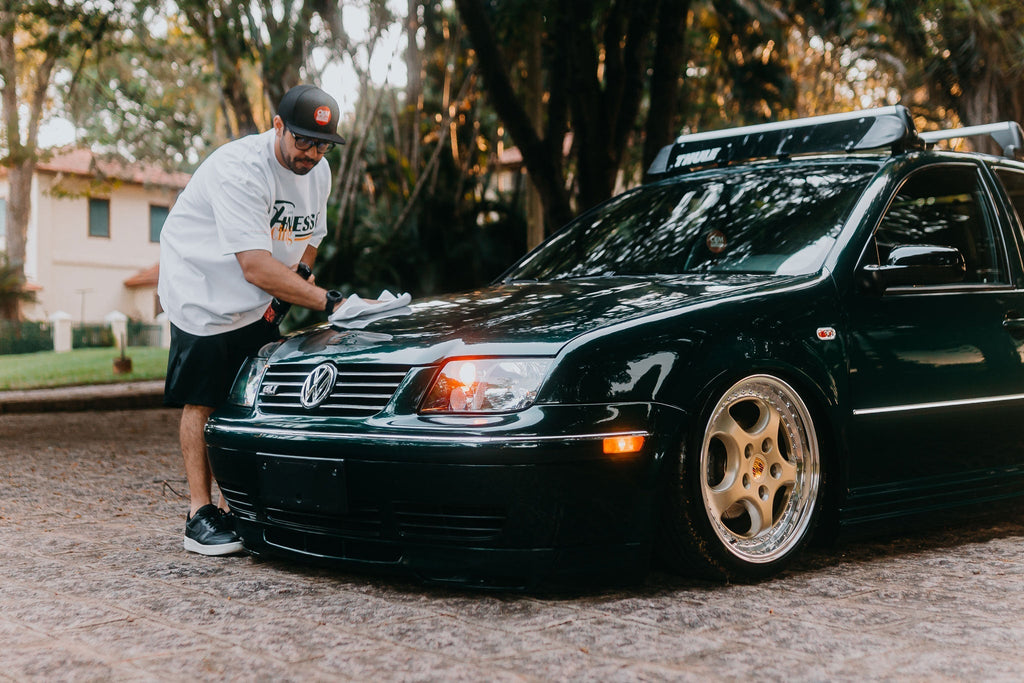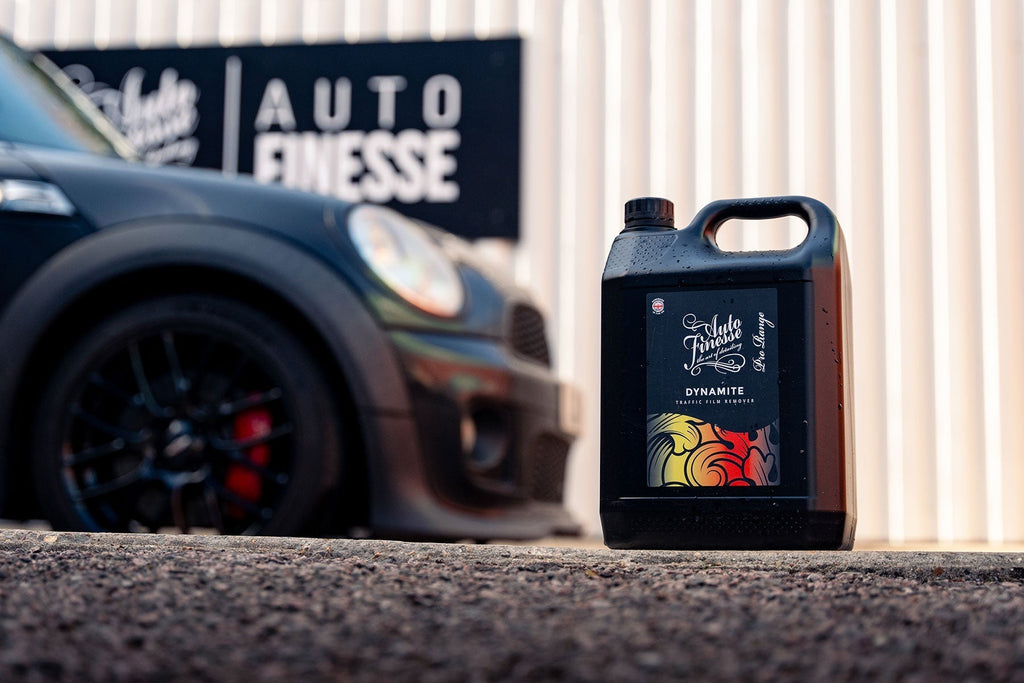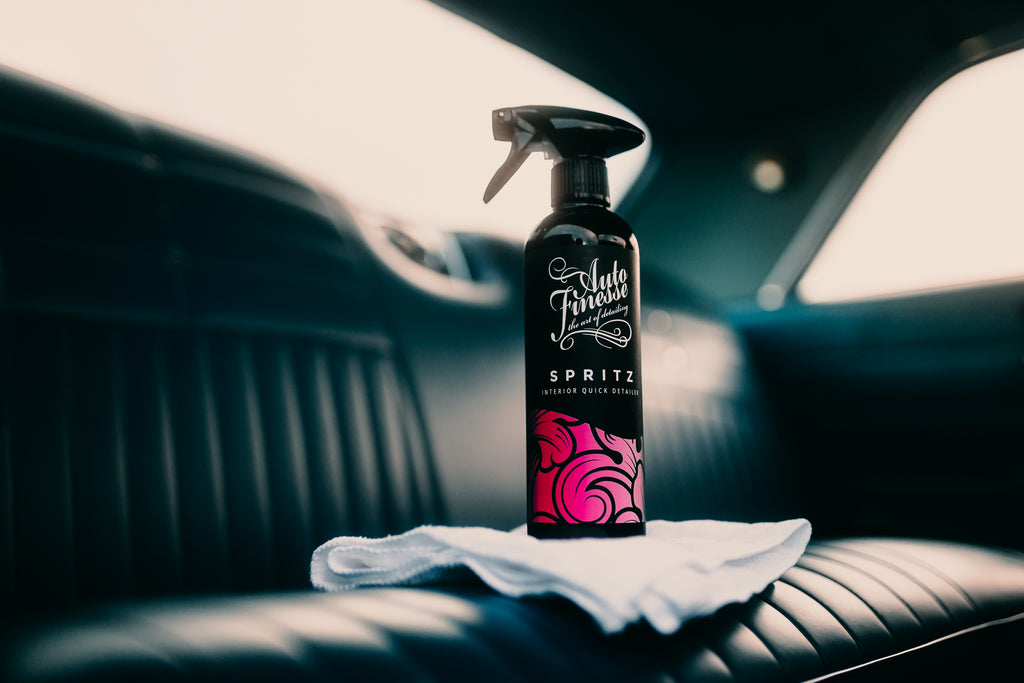How To Restore Gloss Plastic Trim

In This Guide You Will:
- Learn the safe method to restore and rejuvenate faded, swirled gloss plastic trim, stopping it detracting from the rest of your detail.
- Explore the essential detailing products to correct any level of swirling quickly and safely.
- Follow our straightforward, step-by-step guide to master each process and save money along the way.
Don't Let Swirled Plastic Trims Spoil Your Next Detail
There's no denying that those piano black pillar trims are a headache for car enthusiasts everywhere. Even our Pro Detailers often joke, "Don't even look at them, they'll scratch!" It's a common concern: how do you clean these trims safely and fully restore them when they're covered in swirl marks? And what are the best detailing products to use along the way?
Even on relatively new cars, these areas often look scratched and swirled. This isn't just because they're among the most vulnerable parts of the car (especially when poor washing techniques are involved), but also because they get a lot of contact — from brushing against hedges on the road, people passing by in the parking lot, or simply because pillar trims are often the first thing people grab when closing a door.
So, aside from avoiding contact as much as possible and using the safest cleaning routine, how can you bring these trims back to life? Here's how you can stop your plastic pillars from spoiling your next detail…

What Makes Gloss Plastics Different From Other Panels?
While some manufacturers apply lacquer or gelcoat to their plastic trims, which arguably makes polishing a bit safer, most vehicles have piano black plastics that are simply bare acrylic. Unlike painted surfaces, acrylic plastics have a much softer surface. This means that careful cleaning and using a safe pre-wash before making contact are essential to minimize the risk of causing swirls. As with any detailing, prevention is always better than cure.
Unlike paintwork, which consists of multiple layers (primer, topcoat, and clear coat) applied to a metal or plastic base, pillar trims are a single piece of acrylic plastic with no protective layers. This lack of a protective layer makes the surface more vulnerable to damage.
This distinction becomes especially important when using abrasives to correct or refine the plastic surface. Heat can quickly travel through and be trapped in the entire piece, which is a major concern during correction. Unlike painted surfaces, plastic doesn’t dissipate heat well, making it more prone to warping or even burning, which can cause hazing. Additionally, heat softens the surface, making it stickier on a microscopic level and more difficult to correct.
On unlacquered plastics, the glossy finish comes from light reflecting directly off the surface, not from light passing through a clear coat and reflecting off paint underneath. This makes defects like swirl marks and acid etching more noticeable and easier to inflict. As a result, plastic trims can appear far worse than the rest of the vehicle, even when defects are comparable. When polishing any painted or gloss plastic surface, we always use a Swirl Spotter Detailing Light, but these imperfections are particularly evident in sunlight.

Should You Hand Or Machine Polish Gloss Plastic Trims?
The short answer is that either method can achieve the desired results. While it is certainly possible to restore and refine gloss plastic trims by hand, we recommend using our Revitalise Spot Pads with an ergonomic Handi Puck for the best results. Just keep in mind that hand polishing will take significantly longer than using a machine polisher.
When opting for machine polishing on smaller areas like these, it's essential to choose the right machine and pad size. In most cases, a small 3-inch machine, such as our MPX Dual Action Polisher, is ideal for this type of work.
As mentioned earlier, heat is the primary concern when polishing plastic. To minimize heat build-up, a Dual Action (DA) machine is recommended, as its orbital rotation helps keep the pad cool. Additionally, using shorter set times and lower speeds is key to avoiding excess heat. Professional detailers typically move the machine across the panel at about twice the speed they would use on paintwork. To learn more about different types of machine polishers and how they work, be sure to check out our Basic Guide to Machine Polishing.

What Combo Is Best For Use On Gloss Plastics?
The approach you take will depend on both the desired outcome and the level of defects you're aiming to remove. In some cases, you may need to use a slightly less aggressive pad and compound than you would for painted surfaces.
Typically, unless you're correcting very light swirling or working on plastics that have already been detailed (in which case Tripple All-in-One Polish is great for enhancement), restoring these trims is rarely a one-step process. Much like paintwork correction, a cutting stage is usually necessary to remove defects, followed by a refining stage to finish and eliminate the hazing left from the cutting process.
For heavier swirl marks, a three-stage correction may be required, starting with a coarser compound for the initial cut, followed by progressively finer compounds for cutting and refining. Even in these cases, it's always a good idea to begin with a finer compound than you think you'll need, assess the results, and then switch to a heavier cut only if necessary. While cutting plastics is generally easier than cutting clearcoat, achieving a flawless finish can be more challenging due to the softness of the surface and the tendency to pick up more defects during the refining stages.
In our guide below we're using our Revitalise System V2 Compounds which are designed specifically to make getting professional results at home easy. But you can also use our 3-grades of Pro Series Compounds.



Can You Protect Gloss Plastics?
The final stage of protection is essential to preserve your work and make cleaning easier in the future. The key is to avoid introducing new defects into your freshly polished trim. Even something as seemingly harmless as a dusty microfibre cloth can scratch acrylic surfaces. With this in mind, we recommend using products that are gentle and safe to apply.
Both our Ceramic Spray Wax and Glisten Spray Wax offer excellent protection for gloss plastic trims, but keep in mind that your choice of protection can impact the polish or compound you use during the final refinement stage.
For instance, if you're simply enhancing the panel and removing light defects with Tripple All-in-One Polish, a ceramic coating isn't ideal because the carnauba wax in Tripple can interfere with the bonding process. The durable winter protection offered by Ceramic requires the use of correction products that don't contain wax, making our Revitalise System and Pro Series Compounds the best option for cutting and refining.
On the other hand, Glisten Spray Wax can be applied over both Revitalise and Tripple, providing a quick and easy solution with just a spray and a wipe.


Step-By-Step Process
For our guide, we addressed some gloss black pillar trims that were in need of attention by performing a three-stage correction with our MPX Dual Action Polisher, our Revitalise System V2 Compounds and colour-coded Revitalise Spot Pads.

Step 1 - Inspection & Masking
As with any polishing process, it's crucial that the surface is completely clean, dry, and free of any embedded contaminants. Cleaning exterior plastic trim should follow the same steps as cleaning paintwork—start with a pre-wash using Citrus Power Bug & Grime Remover and Avalanche Snow Foam, followed by a safe two-bucket car wash with Lather Car Shampoo. Keep in mind that any additional decontamination should only be done when absolutely necessary, as you want to avoid causing new defects. To dry your trim, always use a super-soft Aqua Deluxe Drying Towel to prevent any damage.
Next, use Detailers Masking Tape to mask off the plastic panels. This step is important not only to protect the surrounding rubber, which can be stained by compounds, but also to prevent additional defects from occurring. Hard rubber rubbing against your pad can heat up, melt, and stick, transferring that onto your glossy plastics when you're working with a fast-moving foam pad. This can easily result in deeper scratches.

Step 2 - Testing
The initial cutting stage is where the most severe defects are addressed, leveling them down to their lowest point. Instead of removing the defect itself, the process removes the surrounding surface material until the deepest part of the defect is reached, effectively making the swirls and scratches disappear.
Looking at this panel, we can immediately see the heavy swirling. Our experienced detailer knows from the outset that all three stages of the Revitalise System will likely be needed, which include a coarse, medium, and fine cut process. However, we begin by testing with the medium-cut Revitalise No:2 Polishing Compound and a medium Revitalise No:2 Spot Pad to see if it’s enough to remove the swirling.
As always, when using new pads, particularly on gloss plastics, it’s important to apply a little Pad Prime to avoid initial scrubbing.
Only a few pea-sized drops of compound are needed. We first pat the compound around the panel to evenly distribute it, then start the machine at a moderate speed. Moving quickly across the panel helps prevent heat buildup from the pad, which in turn reduces the heat in any one spot.
After the first pass, we increase the speed for a second pass, working through the compound fully until the residue becomes clear.
Once we wipe away the residue with a fresh microfibre cloth, we can see that the results are good, and the majority of swirling has been removed. However, deeper defects remain, indicating that a coarser compound is necessary. With this in mind, we decide to use the Revitalise No:1 Restoring Compound for the initial cut, followed by the medium No:2 Polishing Compound and fine No:3 Refining Compound (all with their corresponding Revitalise Spot Pads) to finish. The colour coding of the compounds and pads makes the process straightforward.



Step 3 - Cutting
We began with our coarse Restoring Compound and firm pad, applying it in the same manner. The heavier cut quickly eliminated the remaining defects, allowing us to switch back to the Revitalise No:2 Polishing Compound and Revitalise No:2 Spot Pad. We repeated the process to remove the heavier hazing left from the initial coarse cut.
For more details on how different pads work, check out our article: The Ultimate Guide To Polishing Pads.





Step 4 - Refining
After completing the second round of cutting, the refining stage is where we focus on eliminating any remaining visible marks. This step is performed in the same manner, but this time using our fine Revitalise No:3 Refining Compound and a soft foam Revitalise No:3 Spot Pad.
While refining is technically still a form of cutting, it refers to the final stage where we use fine abrasives to achieve a smooth, flawless finish. The goal is to remove any hazing from the previous stage and restore the glossy appearance of the plastic.




Step 5 - Protection
Once the processes are completed on both sides of the trim and the car, the trim is fully restored. After removing the masking tape, the final step is to apply some protection.
As mentioned, both Ceramic Spray Wax and Glisten Spray Wax are great options for quick and easy protection here and can be used alongside our Revitalise V2 and Pro Series Compounds, as these products contain no waxes or fillers. In this case, we chose to apply a quick spritz of Glisten for up to a month of protection and an added gloss. We’ll top it up after each maintenance wash.












Glisten is a high-tech spray car wax specifically developed for a speedy finish with 4-weeks of protection and acres of gloss… and all with nothing more than a... See product details More
And that's how you restore and protect gloss plastics in just a few easy steps. Why not adapt this guide to your next detail and ensure that those swirly plastics never detract from you results ever again.
For more top how-tos and product knowledge check out the Guides Section Of Our Blog.
















































